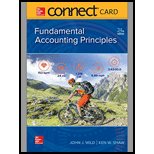
Connect Access Card For Fundamental Accounting Principles
24th Edition
ISBN: 9781260158526
Author: John J Wild
Publisher: McGraw-Hill Education
expand_more
expand_more
format_list_bulleted
Concept explainers
Textbook Question
Chapter 6, Problem 5APSA
Problem 6-5A
Lower of cost or market
P2
A physical inventory of Liverpool Company taken at December 31 reveals the following.

Required
1. Compute the lower of cost or market for the inventory applied separately to each item.
2. If the market amount is less than the recorded cost of the inventory, then record the LCM adjustment to the Merchandise Inventory account.
Expert Solution & Answer
Want to see the full answer?
Check out a sample textbook solution
Students have asked these similar questions
The comparative balance sheets and an income statement for Raceway Corporation follow.
Balance Sheets
As of December 31
Year 2
Year 1
Assets
Cash
$ 6,300
$ 48,400
Accounts receivable
10,200
7,260
Inventory
45,200
56,000
Prepaid rent
700
2,140
Equipment
140,000
144,000
Accumulated depreciation
(73,400)
(118,000)
Land
116,000
50,000
Total assets
$ 245,000
$ 189,800
Liabilities
Accounts payable (inventory)
$ 37,200
$ 40,000
Salaries payable
12,200
10,600
Stockholders’ equity
Common stock, $50 par value
150,000
120,000
Retained earnings
45,600
19,200
Total liabilities and stockholders’ equity
$ 245,000
$ 189,800
Income Statement
For the Year Ended December 31, Year 2
Sales
$ 480,000
Cost of goods sold
(264,000)
Gross profit
216,000
Operating expenses
Depreciation expense
(11,400)
Rent expense
(7,000)
Salaries expense
(95,200)
Other operating expenses
(76,000)
Net income
$ 26,400
Other Information
Purchased…
Please help holy tamale I have been staring at this for hours.
Could you explain the steps for solving this financial accounting question accurately?
Chapter 6 Solutions
Connect Access Card For Fundamental Accounting Principles
Ch. 6 - Prob. 1DQCh. 6 - Where is the amount of merchandise inventory...Ch. 6 - If costs are declining, will the LIFO or FIFO...Ch. 6 - Prob. 4DQCh. 6 - Prob. 5DQCh. 6 - Prob. 6DQCh. 6 - Prob. 7DQCh. 6 - Prob. 8DQCh. 6 - Prob. 9DQCh. 6 - Prob. 10DQ
Ch. 6 - Prob. 11DQCh. 6 - Prob. 12DQCh. 6 - Inventory ownership Homestead Crafts, a...Ch. 6 - QS 6-2 Inventory costs C2
A car dealer acquires a...Ch. 6 - Prob. 3QSCh. 6 - Perpetual: Inventory costing with FIFO P1 A...Ch. 6 - Perpetual: Inventory costing with LIFO Refer to...Ch. 6 - Perpetual Inventory costing with weighted average...Ch. 6 - Periodic: Inventory costing with FIFO P3 Refer to...Ch. 6 - Periodic: Inventory costing with LIFO Refer to the...Ch. 6 - Periodic: Inventory costing with weighted average...Ch. 6 - Perpetual: Assigning costs with FIFO Trey Monson...Ch. 6 - QS6-11
Perpetual Inventory costing with LIFO
Refer...Ch. 6 - QS 6-12
Perpetual: Inventory costing with weighted...Ch. 6 - QS6.13
Perpetual Inventory costing with specific...Ch. 6 - Periodic: Inventory costing with FIFO P3 Refer to...Ch. 6 - Periodic Inventory costing with LIFO P3 Refer to...Ch. 6 - Periodic: Inventory costing with weighted average...Ch. 6 - Periodic: Inventory costing with specific...Ch. 6 - QS 6-18 Contrasting inventory costing methods...Ch. 6 - Prob. 19QSCh. 6 - Inventory errors A2 In taking a physical inventory...Ch. 6 - Analyzing inventory A3 Endor Company begins the...Ch. 6 - Prob. 22QSCh. 6 - Inventory costs C2 A solar panel dealer acquires a...Ch. 6 - Exercise 6-1 Inventory ownership C1
1. At...Ch. 6 - Exercise 6-2
Inventory costs
C2
Walberg...Ch. 6 - Exercise 6-3 Perpetual Inventory costing methods...Ch. 6 - Exercise 6-4 Perpetual: Income effects of...Ch. 6 - Exercise 6-5A Periodic: Inventory costing P3 Refer...Ch. 6 - Exercise 6-6A Periodic: Income effects of...Ch. 6 - Exercise 6-7 Perpetual Inventory costing...Ch. 6 - Exercise 6.8 Specific identification Refer to the...Ch. 6 - Prob. 9ECh. 6 - Prob. 10ECh. 6 - Prob. 11ECh. 6 - Prob. 12ECh. 6 - Exercise 6-13 Inventory turnover and days' sales...Ch. 6 - Prob. 14ECh. 6 - Prob. 15ECh. 6 - Prob. 16ECh. 6 - Prob. 17ECh. 6 - Exercise 6-1E Perpetual inventory costing P1 Tree...Ch. 6 - Exercise 6-19APeriodic inventory costing P3 I...Ch. 6 - Problem 6-1A
Perpetual: Alternative cost...Ch. 6 - Prob. 2APSACh. 6 - Prob. 3APSACh. 6 - Prob. 4APSACh. 6 - Problem 6-5A Lower of cost or market P2 A physical...Ch. 6 - Prob. 6APSACh. 6 - Prob. 7APSACh. 6 - Prob. 8APSACh. 6 - Prob. 9APSACh. 6 - Prob. 10APSACh. 6 - Prob. 1BPSBCh. 6 - Prob. 2BPSBCh. 6 - Prob. 3BPSBCh. 6 - Prob. 4BPSBCh. 6 - Prob. 5BPSBCh. 6 - Prob. 6BPSBCh. 6 - Prob. 7BPSBCh. 6 - Prob. 8BPSBCh. 6 - Prob. 9BPSBCh. 6 - Prob. 10BPSBCh. 6 - Prob. 6SPCh. 6 - AA 6-1 Use Apple's financial statements in...Ch. 6 - AA 6-2 Comparative figures for Apple and Google...Ch. 6 - Prob. 3AACh. 6 - BTN 6-3 Golf Challenge Corp. is a retail sports...Ch. 6 - Prob. 2BTNCh. 6 - Prob. 3BTNCh. 6 - Prob. 4BTNCh. 6 - Prob. 5BTNCh. 6 - Prob. 6BTN
Knowledge Booster
Learn more about
Need a deep-dive on the concept behind this application? Look no further. Learn more about this topic, accounting and related others by exploring similar questions and additional content below.Similar questions
- I need help with this General accounting question using the proper accounting approach.arrow_forwardPlease explain the solution to this general accounting problem with accurate principles.arrow_forwardKindly help me with this General accounting questions not use chart gpt please fast given solutionarrow_forward
- I am searching for the correct answer to this Financial accounting problem with proper accounting rules.arrow_forwardI am looking for the correct answer to this Financial accounting question with appropriate explanations.arrow_forwardEcho Tone Technologies reports annual sales of $90,000, and it expects sales to increase to $135,000 next year. The company has a degree of operating leverage (DOL) of 4.2. By what percentage should net income increase? A. 70% B. 189% C. 150% D. 210%arrow_forward
- Please provide the accurate answer to this general accounting problem using valid techniques.arrow_forwardNo chatgpt Which account will appear in the post-closing trial balance?A. Rent ExpenseB. Sales RevenueC. DividendsD. Capitalarrow_forwardI need help with this financial accounting question using the proper accounting approach.arrow_forward
arrow_back_ios
SEE MORE QUESTIONS
arrow_forward_ios
Recommended textbooks for you
 Cornerstones of Financial AccountingAccountingISBN:9781337690881Author:Jay Rich, Jeff JonesPublisher:Cengage Learning
Cornerstones of Financial AccountingAccountingISBN:9781337690881Author:Jay Rich, Jeff JonesPublisher:Cengage Learning Corporate Financial AccountingAccountingISBN:9781305653535Author:Carl Warren, James M. Reeve, Jonathan DuchacPublisher:Cengage Learning
Corporate Financial AccountingAccountingISBN:9781305653535Author:Carl Warren, James M. Reeve, Jonathan DuchacPublisher:Cengage Learning Corporate Financial AccountingAccountingISBN:9781337398169Author:Carl Warren, Jeff JonesPublisher:Cengage Learning
Corporate Financial AccountingAccountingISBN:9781337398169Author:Carl Warren, Jeff JonesPublisher:Cengage Learning Financial & Managerial AccountingAccountingISBN:9781337119207Author:Carl Warren, James M. Reeve, Jonathan DuchacPublisher:Cengage Learning
Financial & Managerial AccountingAccountingISBN:9781337119207Author:Carl Warren, James M. Reeve, Jonathan DuchacPublisher:Cengage Learning AccountingAccountingISBN:9781337272094Author:WARREN, Carl S., Reeve, James M., Duchac, Jonathan E.Publisher:Cengage Learning,
AccountingAccountingISBN:9781337272094Author:WARREN, Carl S., Reeve, James M., Duchac, Jonathan E.Publisher:Cengage Learning, Accounting (Text Only)AccountingISBN:9781285743615Author:Carl Warren, James M. Reeve, Jonathan DuchacPublisher:Cengage Learning
Accounting (Text Only)AccountingISBN:9781285743615Author:Carl Warren, James M. Reeve, Jonathan DuchacPublisher:Cengage Learning

Cornerstones of Financial Accounting
Accounting
ISBN:9781337690881
Author:Jay Rich, Jeff Jones
Publisher:Cengage Learning

Corporate Financial Accounting
Accounting
ISBN:9781305653535
Author:Carl Warren, James M. Reeve, Jonathan Duchac
Publisher:Cengage Learning

Corporate Financial Accounting
Accounting
ISBN:9781337398169
Author:Carl Warren, Jeff Jones
Publisher:Cengage Learning

Financial & Managerial Accounting
Accounting
ISBN:9781337119207
Author:Carl Warren, James M. Reeve, Jonathan Duchac
Publisher:Cengage Learning

Accounting
Accounting
ISBN:9781337272094
Author:WARREN, Carl S., Reeve, James M., Duchac, Jonathan E.
Publisher:Cengage Learning,

Accounting (Text Only)
Accounting
ISBN:9781285743615
Author:Carl Warren, James M. Reeve, Jonathan Duchac
Publisher:Cengage Learning
Chapter 6 Merchandise Inventory; Author: Vicki Stewart;https://www.youtube.com/watch?v=DnrcQLD2yKU;License: Standard YouTube License, CC-BY
Accounting for Merchandising Operations Recording Purchases of Merchandise; Author: Socrat Ghadban;https://www.youtube.com/watch?v=iQp5UoYpG20;License: Standard Youtube License